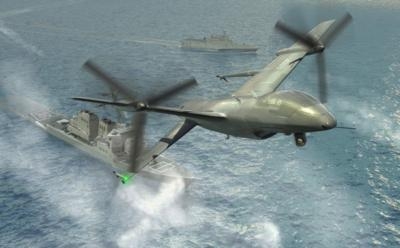Thu, Mar 26, 2015
System Would Enable Small Ships To Host Their Own Unmanned Air Systems
DARPA has awarded prime contracts for Phase 2 of Tern, a joint program between DARPA and the U.S. Navy’s Office of Naval Research (ONR). The goal of Tern is to give forward-deployed small ships the ability to serve as mobile launch and recovery sites for medium-altitude, long-endurance unmanned aerial systems (UAS).

These systems could provide long-range intelligence, surveillance and reconnaissance (ISR) and other capabilities over greater distances and time periods than is possible with current assets, including manned and unmanned helicopters. Further, a capacity to launch and retrieve aircraft on small ships would reduce the need for ground-based airstrips, which require significant dedicated infrastructure and resources. The two prime contractors selected by DARPA are AeroVironment, Inc., and Northrop Grumman Corp.
“To offer the equivalent of land-based UAS capabilities from small-deck ships, our Phase 2 performers are each designing a new unmanned air system intended to enable two previously unavailable capabilities: one, the ability for a UAS to take off and land from very confined spaces in elevated sea states and two, the ability for such a UAS to transition to efficient long-duration cruise missions,” said Dan Patt, DARPA program manager. “Tern’s goal is to develop breakthrough technologies that the Navy could realistically integrate into the future fleet and make it much easier, quicker and less expensive for the Defense Department to deploy persistent ISR and strike capabilities almost anywhere in the world.”
The first two phases of the Tern program focus on preliminary design and risk reduction. In Phase 3, one performer will be selected to build a full-scale demonstrator Tern system for initial ground-based testing. That testing would lead to a full-scale, at-sea demonstration of a prototype UAS on an at-sea platform with deck size similar to that of a destroyer or other surface combat vessel.
(DARPA artist's concept)
More News
Light Gun A handheld directional light signaling device which emits a brilliant narrow beam of white, green, or red light as selected by the tower controller. The color and type of>[...]
"The journey to this achievement started nearly a decade ago when a freshly commissioned Gentry, driven by a fascination with new technologies and a desire to contribute significan>[...]
Aero Linx: JAARS, Inc. For decades now, we’ve landed planes on narrow rivers and towering mountains. We’ve outfitted boats and vehicles to reach villages that rarely se>[...]
"Our driven and innovative team of military and civilian Airmen delivers combat power daily, ensuring our nation is ready today and tomorrow." Source: General Duke Richardson, AFMC>[...]
Aircraft Conflict Predicted conflict, within EDST of two aircraft, or between aircraft and airspace. A Red alert is used for conflicts when the predicted minimum separation is 5 na>[...]
 ANN's Daily Aero-Term (04.20.24): Light Gun
ANN's Daily Aero-Term (04.20.24): Light Gun Aero-News: Quote of the Day (04.20.24)
Aero-News: Quote of the Day (04.20.24) ANN's Daily Aero-Linx (04.21.24)
ANN's Daily Aero-Linx (04.21.24) Aero-News: Quote of the Day (04.21.24)
Aero-News: Quote of the Day (04.21.24) ANN's Daily Aero-Term (04.21.24): Aircraft Conflict
ANN's Daily Aero-Term (04.21.24): Aircraft Conflict



